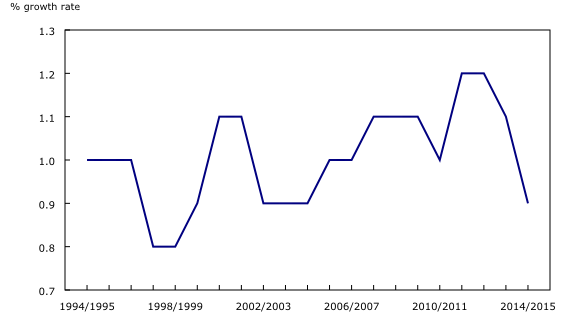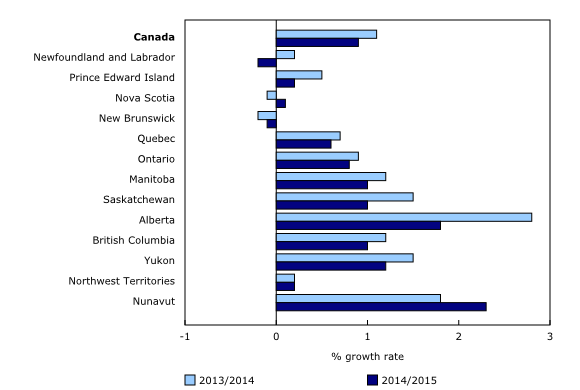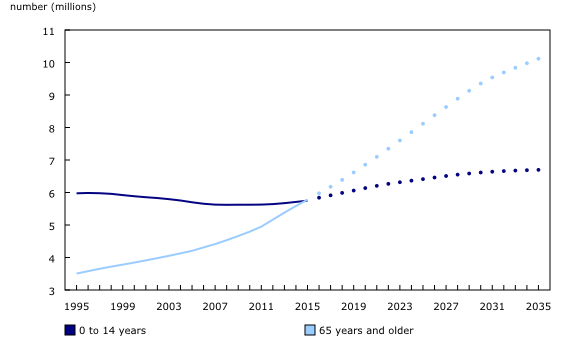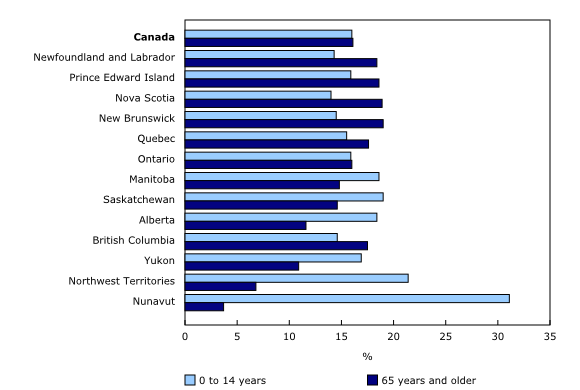Canada's population estimates: Age and sex, July 1, 2015
Archived Content
Information identified as archived is provided for reference, research or recordkeeping purposes. It is not subject to the Government of Canada Web Standards and has not been altered or updated since it was archived. Please "contact us" to request a format other than those available.
Released: 2015-09-29
On July 1, 2015, Canada's estimated population was 35,851,800, up 308,100 or 0.9% over the last year (2014/2015). Although this was the lowest population increase since 1998/1999, it was the largest increase among the G7 countries over the most recent comparable annual period.
For the first time, the number of persons aged 65 years and older exceeded the number of children aged 0 to 14 years.
Population growth slows
Preliminary estimates show that the annual population growth rate slowed to 0.9% in 2014/2015, down from 1.1% in 2013/2014. This was mainly driven by a slowdown in international migration growth, from 0.7% in 2013/2014 to 0.5% in 2014/2015.
Between July 1, 2014, and June 30, 2015, Canada received 239,800 immigrants, down from 267,900 in 2013/2014. In addition, the number of non-permanent residents decreased (-10,300) for the first time since 1997/1998.
Although international migration growth slowed, it remained the main lever of population growth, accounting for 60.8% of the population growth in 2014/2015. In comparison, natural increase accounted for 39.2% of the population growth.
Canada's population growth is the highest among the G7 countries
For the most recent comparable annual period (see the note to readers), Canada's population growth rate (+0.9%) was the highest among the G7 countries, exceeding that of the United States (+0.7%), the United Kingdom (+0.2%), France (+0.2%), Germany (+0.1%), as well as Italy and Japan, whose populations were stable.
Population growth remains high in Alberta, despite a significant decline
Population growth was lower in 2014/2015 compared with 2013/2014 in most provinces, especially Alberta. Alberta's population growth rate fell 1.0 percentage point to 1.8%. Despite this decrease, this rate was twice the national average.
The slowdown in Alberta's population growth was primarily attributable to a decrease in net international migration, which was 13,100 in 2014/2015 compared with 44,900 in 2013/2014. Smaller gains from interprovincial migration in 2014/2015 (+28,900) than in 2013/2014 (+35,400) also contributed to the slowdown in province's population growth.
Nunavut and Western Canada continue to record the highest population growth rates
Population growth varied among the provinces and territories in 2014/2015. Growth was above the national average in Nunavut (+2.3%), Alberta (+1.8%), Yukon (+1.2%), Saskatchewan (+1.0%), Manitoba (+1.0%) and British Columbia (+1.0%).
The population decreased in two provinces, Newfoundland and Labrador (-0.2%) and New Brunswick (-0.1%).
Canada's population is concentrated in four provinces
On July 1, 2015, nearly 31 million Canadians (86.3%) were living in one of four provinces, namely Ontario (38.5%), Quebec (23.0%), British Columbia (13.1%) and Alberta (11.7%).
Ontario remained Canada's most populous province, with 13,792,100 persons, followed by Quebec, with 8,263,600 persons.
The number of non-permanent residents decreases
From July 1, 2014 to June 30, 2015, the number of non-permanent residents declined by 10,300. This was the largest annual decrease since 1994/1995 (-14,200).
In 2014/2015, the number of non-permanent residents declined mainly in Alberta (-21,200), but also in Saskatchewan (-2,200), New Brunswick (-200) and the territories (-100).
In other parts of Canada, the number of non-permanent residents increased, but generally more slowly than in 2013/2014.
Persons aged 65 years and older outnumber children 0 to 14 years
On July 1, 2015, preliminary estimates show that, for the first time, there were more persons aged 65 years and older in Canada than children aged 0 to 14 years. Nearly one in six Canadians (16.1%)—a record 5,780,900 Canadians—was at least 65 years old, compared with 5,749,400 children aged 0 to 14 years (16.0%).
According to the most recent population projections (see the note to readers), the share of persons aged 65 years and older will continue to increase and should account for 20.1% of the population on July 1, 2024, while the share of children aged 0 to 14 years should account for 16.3%.
Baby boomers accelerate Canada's population aging
In 2014/2015, the growth rate of the population aged 65 years and older was 3.5%, approximately four times the growth rate of the total population.
The annual growth rate of this age group has accelerated since 2011, when the first members of the baby boom generation (persons born between 1946 and 1965) turned 65. On July 1, 2015, 18.2% of baby boomers were aged 65 years and older.
Canada is younger than most G7 countries
Population aging is a widespread phenomenon in the industrialized world. In recent years, the proportion of persons aged 65 years and older has grown in every G7 country.
Of the G7 countries, the United States (15%) and Canada (16.1%) have the lowest proportions of persons aged 65 years and older. Conversely, Japan's population is among the oldest in the world, with the highest proportion of persons aged 65 years and older (26%) among the G7 countries.
The population is aging less quickly in the Prairie provinces and the territories
The age structure of the population varied greatly among the provinces and territories. On July 1, 2015, the number of persons aged 65 years and older was higher than the number of children aged 0 to 14 years in the Atlantic provinces, Quebec, Ontario and British Columbia.
However, in the Prairie provinces and the territories, there were more children aged 0 to 14 years than persons aged 65 years and older.
The population is older in the Atlantic provinces
On July 1, 2015, New Brunswick was the province with the highest proportion of persons aged 65 years and older (19.0%). Conversely, the lowest proportion in Canada was in Nunavut (3.7%). Of the provinces, Alberta had the lowest proportion (11.6%).
The ratio of persons aged 65 years and older to children aged 0 to 14 years was highest in Nova Scotia (1.35) and lowest in Nunavut (0.12). The ratio for Canada was 1.01, meaning that the demographic weight of persons aged 65 years and older was slightly greater than that of children aged 0 to 14 years.
Note to readers
Estimates by age and sex in this release are based on 2011 Census counts adjusted for census net undercoverage and incompletely enumerated Indian reserves, to which the estimated population growth from May 10, 2011 to June 30, 2015 is added.
This release focuses mainly on preliminary postcensal population estimates by age and sex on July 1, 2015. The estimates presented in this release are subject to revision. Future updates could affect the trends observed and analyzed in this release.
Population growth rates are calculated using the average of the populations at the beginning and end of the period as a denominator. A rate that is higher than negative 0.1% but lower than 0.1% is considered not to be significant.
The G7 is an informal discussion group and economic partnership consisting of seven of the world's most powerful economies, namely the United States, Japan, Germany, France, the United Kingdom, Italy and Canada. Population growth rate data on these countries (not including Canada) are from Eurostat (January 2014 to January 2015), the Statistics Bureau of Japan (August 2014 to August 2015) and the US Census Bureau (July 2014 to July 2015). The calculations were performed by Statistics Canada. Data on age distribution of the population (not including Canada) are from the Population Reference Bureau and are rounded to the unit as shown in the source used.
The population projections in this release are based on the M1 scenario (medium growth, trends from 1991/1992 to 2010/2011) presented in the publication Population Projections for Canada (2013 to 2063), Provinces and Territories (2013 to 2038) (91-520-X).
The 2014/2015 reference period is the period from July 1, 2014 to June 30, 2015, while the 2013/2014 reference period is the period from July 1, 2013 to June 30, 2014.
Definitions
Natural increase is the difference between the numbers of births and deaths.
Net international migration basically refers to the total number of moves between Canada and abroad that result in a change in the usual place of residence. It is calculated by adding immigration, returning emigration and net non-permanent residents and by subtracting emigration and net temporary emigration.
Net non-permanent residents correspond to the variation in the number of non-permanent residents between two dates.
Products
The Annual Demographic Estimates: Canada, Provinces and Territories, 2015 (91-215-X), is now available from the Browse by key resource module of our website under Publications.
The Quarterly Demographic Estimates, Vol. 29, no. 2 (91-002-X), is also available from the Browse by key resource module of our website under Publications.
The infographic "Population Estimates, Canada, 2015," which is part of Statistics Canada – Infographics (11-627-M), is also now available from the Browse by key resource module of our website under Publications. This infographic is based on this release and gives an overview of the latest demographic trends in Canada.
Contact information
For more information, or to enquire about the concepts, methods or data quality of this release, contact us (toll-free 1-800-263-1136; 514-283-8300; infostats@statcan.gc.ca) or Media Relations (613-951-4636; statcan.mediahotline-ligneinfomedias.statcan@canada.ca).
- Date modified:






